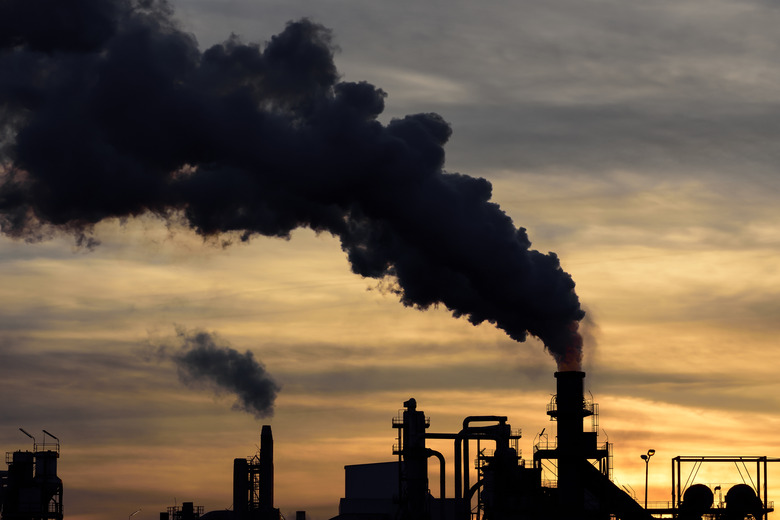How Do Factories Cause Air Pollution?
The presence of chemicals, particulates or biological compounds in the atmosphere can harm human and animal health and damage the environment. Factories and other industrial installations have caused such pollution since the dawn of the industrial age by burning fuels, carrying out chemical processes and releasing dust and other particulates. Air pollution can be controlled through the installation of filters and scrubbers to clean exhaust fumes from factory processes, and by taking steps to minimize the generation of pollution at the source.
Energy Sources
Energy Sources
Factories need an energy source to power their production processes. In the United States, this has been electricity generated by fossil fuel burning, in particular coal. Air pollutants emitted by coal-fired power plants include nitrogen and sulfur oxides, hydrogen chloride and hydrogen fluoride gases, and arsenic, lead and other metals. Power generation for factories may cause greater air pollution than the factory processes. Natural gas is the least polluting fossil fuel for power generation. It emits nitrogen oxides and carbon dioxide on burning but in far lower quantities than coal
Metal Smelting
Metal Smelting
Metals provide machine components, vehicles, instruments and infrastructure in factories. Metal smelters that process and refine mineral ores and scrap metal create silica and metallic dusts during initial crushing and grinding. Heating and smelting processes produce emissions of sulfur and carbon oxides. Aluminum smelting can emit arsenic particulates, while lead and gold refining produces mercury and cyanide emissions.
Petrochemical Smog
Petrochemical Smog
Factory processes involve varied combinations of cleaning, painting and heating, while other raw material or appliance treatments release volatile organic compounds into the atmosphere. These are carbon- or hydrocarbon-based chemicals that quickly evaporate in the air. In the presence of sunlight, they react with other air pollutants like sulfur or nitrogen oxides from vehicle exhausts to create peroxyacetyl nitrates, commonly known as photochemical smog. This looks like a thick brown haze and can linger for days or weeks over urban centers.
Food Processing
Food Processing
The food processing industry uses a wide range of methods for the preparation, cooking and packaging of foodstuffs that release particulates into the atmosphere. Bulk material handling of grains and flour produce dust. Frying and smoking processes release soot into the air. Rendering and washing in meat and fish processing plants produces volumes of liquid waste that leaves mold and bacterial residues that also pollute the air.
Cite This Article
MLA
Kielmas, Maria. "How Do Factories Cause Air Pollution?" sciencing.com, https://www.sciencing.com/factories-cause-air-pollution-5169/. 19 April 2018.
APA
Kielmas, Maria. (2018, April 19). How Do Factories Cause Air Pollution?. sciencing.com. Retrieved from https://www.sciencing.com/factories-cause-air-pollution-5169/
Chicago
Kielmas, Maria. How Do Factories Cause Air Pollution? last modified March 24, 2022. https://www.sciencing.com/factories-cause-air-pollution-5169/
